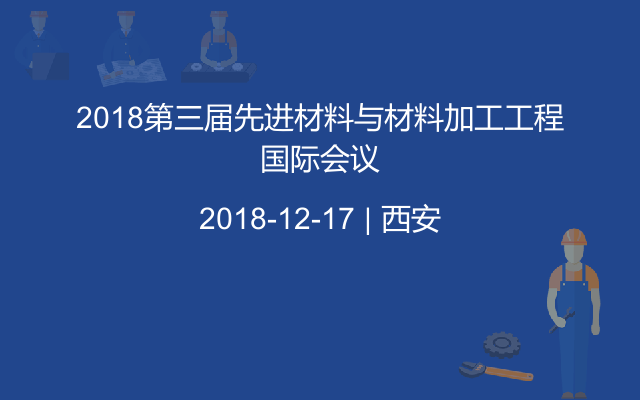上海来溪会务服务有限公司举办《2018第三届先进材料与材料加工工程国际会议》
2018年12月17日 8:00 至 2018年12月19日 18:00 ,上海来溪会务服务有限公司在 西安举办《2018第三届先进材料与材料加工工程国际会议》,会议大约有100人参加。
会议通知
会议内容
主办方介绍

2018第三届先进材料与材料加工工程国际会议宣传图
会议简介:
2018第三届先进材料与材料加工工程国际会议为广大从事先进材料与材料加工工程等相关领域的研究学者、专家提供交流平台。会议组委会诚邀全球相关领域的学者、专家参加此次国际会议,就先进材料与材料加工工程为主题的相关热点问题进行探讨、交流,共同促进全球材料工程的发展。
会议主题:先进材料与材料加工工程
会议时间:2018年12月17-19日
会议地点:中国,西安
论文出版:
所有的录用论文将由 Science Publishing Group出版,录用文章出版于如下期刊:
American Journal of Nanosciences (AJN)
ISSN Print: 2575-484X ISSN Online: 2575-4858
International Journal of Biomedical Materials Research (IJBMR)
ISSN Print: 2330-7560 ISSN Online: 2330-7579
International Journal of Materials Science and Applications (IJMSA)
ISSN Print: 2327-2635 ISSN Online: 2327-2643
Advances in Materials (AM)
ISSN Print: 2327-2503 ISSN Online: 2327-252X
American Journal of Materials Synthesis and Processing (AJMSP)
ISSN Print: 2575-2154 ISSN Online: 2575-1530
Science Discovery (SD)
ISSN Print: 2331-0642 ISSN Online: 2331-0650
(以上合作期刊可被中知网及部分国外的检索机构检索,如WorldCat, Electronic Journals Library, Zeitschriftendatenbank, EZB, Academickeys, ResearchBib, Polish Scholarly Bibliography, Wissenschaftszentrum Berlin等)
会后每篇文章将寄送两本纸质版给国内投稿作者。

上海来溪会务服务有限公司
上海来溪会务服务公司,是一家专业的会务服务公司。以举办国际学术会议为主要业务,涉及会议推广、会议合作、会议组织等。旗下huiyi123.net平台致力于国际学术会议服务,旨在为国内外科研机构、科研团队提供学术会议交流,学术论文出版,酒店预订等会务服务。
会议日程 (最终日程以会议现场为准)
| 12月17日 | 11:00-17:00 | 报到 |
| 12月18日 | 09:00-12:00 | 特邀嘉宾演讲 |
| 12:00-14:00 | 午餐 | |
| 14:00-17:30 | 口头报告 | |
| 18:30-20:00 | 晚宴 | |
| 12月19日 | 08:00-17:00 | 西安一日游 |
会议嘉宾 (最终出席嘉宾以会议现场为准)
ICAMPE2018演讲嘉宾信息如下:
Dr. Alexander Khmaladze, Assistant Professor
Physics Department, University at Albany - State University of New York, Albany, USA
Biography: Dr. Alexander Khmaladze received his Ph.D. in Applied Physics from the University of South Florida in 2008. Having been trained as a physicist who specializes in microscopic imaging and spectroscopy, Dr. Alexander Khmaladze has gradually expanded his work into the domains of chemistry and biology. During the last several years, he has published a number of papers on holographic phase unwrapping, hyperspectral imaging of live cells via CARS Microscopy and Raman spectroscopic analysis of cells, tissues and nanofibers. Due to interdisciplinary nature of my work, it usually involves researchers and students from various scientific backgrounds and interests.
Topic: Characterization of Nanofibers for Tissue Engineering: Chemical Mapping by Confocal Raman Microscopy
Abstract: Nanofiber scaffolds are used in bioengineering for functional support of growing tissues. To fine tune nanofiber properties for specific applications, it is often necessary to characterize the spatial distribution of their chemical content. Raman spectroscopy is a common tool used to characterize chemical composition of various materials, including nanofibers. In combination with a confocal microscope, it allows simultaneous mapping of both spectral and spatial features of inhomogeneous structures, also known as hyperspectral imaging. However, such mapping is usually performed on microscopic scale, due to the resolution of the scanning system being diffraction limited (about 0.2 – 0.5 micron, depending on the excitation wavelength). In this talk, I discuss various ways to characterize nanofibers by SEM, TEM and XRD. I will concentrate on applications of confocal Raman microscopy to hyperspectral mapping of nanofibers, where nanoscale features are resolved by means of oversampling and extensive data processing, including Classical Least Squares (CLS) decomposition and Singular Value Decomposition (SVD) techniques. In many cases, this is the only way to confirm the spatial distribution of different chemical components within multi-component nanofibers.
Dr. Horst E. Friedrich, Professor
Germany Aerospace Center (DLR), Institute of Vehicle Concepts, Germany
Biography: Dr. Horst E. Friedrich studied engineering at the Technical University of Munich. After working in the engineering and consultancy sectors, he took up a senior management position in the aeronautical industry in 1986. He was responsible for new methods of construction and new materials, aircraft engines and optimising product development times. In 1996, Prof. Friedrich joined Volkswagen AG in Wolfsburg as head of vehicle research, where at least he was head of Group research for materials technology and vehicle concepts. He specialised in innovative materials and construction methods and concept vehicles for future vehicle specifications. Here he worked on the projects of vehicles with electric drive: high performance batteries and fuel cells, new lightweight structures with magnesium and carbon fiber construction and the first “1 litre car”. Since 2004 he is Director of the Institute of Vehicle Concepts at the German Aerospace Center in Stuttgart. At the same time he became professor for vehicle concepts at the University of Stuttgart and he is lecturer at the Technical University of Berlin.
Topic: Solutions for Next Generation Car’s Lightweight Requirements Based on Magnesium Concepts and Integrated Functions
Abstract: New vehicle concepts with electric drivetrains and autonomous drive for people movers, passenger or goods cars will change the paradigms of new use cases for mobility. With respect to these requirements also weight saving is a must during an early phase of the concept and structural development process. Addressing energy efficiency, economic and production targets weight saving remains being a must and Magnesium solutions could show here more potentials: casted structures with integrated functions, peeling mode mechanisms or foam filled profiles are examples developed and demonstrated in DLR’s metaproject for Next Generation Car (NGC). Mg extrusions with polyurethane core show up to 3 times better specific energy absorption compared to hollow DC04 steel. Light and cost attractive Mg structures are shown with integrated A-pillar demonstrators, bringing together 20 single parts within one big casting that provides the advantage of 50% weight reduction. Challenges like modularisation strategy and life cycle assessment have to be met. For greenhouse gas emissions over the whole life cycle our comparison gives evidence that different Mg production routes determine the final result and that modern processes are advantageous even compared to an aluminium reference. An overview about optimized a/o new applications will be discussed and shown. Challenges and potentials for next generation lightweight design will be shown and solutions as well as results from the DLR project Next Generation Car.
参会指南
会议门票
参会费用(只参会不投稿)
票务类别 | 包含内容 | 2018年11月27日前缴费 | 2018年11月27日后缴费及现场缴费 |
|---|---|---|---|
C票 | 参会+会议资料+礼品+旅游 | 1600元 | 1800元 |
D票 | 参会+会议资料+礼品+旅游 | 2000元 | 2200元 |